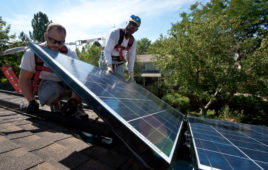As the world grapples with the urgent need to transition towards sustainable energy sources, residential solar adoption has emerged as a key indicator of progress. In an effort to shed light on this crucial aspect, SolarReviews undertook a comprehensive analysis of 400k solar quotes spanning over five years. The findings not only provide valuable insights into the current state of residential solar adoption but also offer glimpses into future trends and potential areas for improvement.
The Evolving Landscape: Unveiling Patterns in Residential Solar Adoption
Through meticulous examination and interpretation of these vast datasets, it becomes evident that residential solar adoption has experienced significant growth over the past five years. This surge can be attributed to various factors such as increasing environmental awareness, declining costs of installation, and government incentives aimed at promoting renewable energy sources.
Furthermore, our analysis reveals intriguing patterns in terms of geographical distribution. While traditionally sunny states like California and Arizona continue to lead in terms of overall installations, there is a noticeable shift towards increased adoption in previously untapped regions such as the Midwest and Southeastern United States.
This expansion beyond traditional strongholds signifies a growing acceptance and recognition among homeowners across diverse locations regarding the benefits offered by solar power systems. It also highlights how technological advancements have made it possible for solar panels to thrive even in less sunny climates.
Challenges Hindering Wider Adoption: Identifying Barriers within Residential Solar Market
Despite its remarkable growth trajectory, residential solar still faces certain challenges that impede wider adoption. One prominent barrier identified through our analysis is affordability. While costs have significantly decreased over time due to economies of scale and improved manufacturing processes, upfront expenses remain prohibitive for many households.
Moreover, the complexity of navigating through various financing options and understanding long-term savings can deter potential adopters. This underscores the need for clearer communication and accessible information to empower homeowners in making informed decisions regarding solar installations.
Additionally, regulatory hurdles at both federal and state levels pose challenges for residential solar adoption. Inconsistencies in policies, permitting processes, and interconnection standards create unnecessary barriers that hinder market growth. Addressing these issues would require collaborative efforts between policymakers, industry stakeholders, and advocacy groups to streamline regulations and foster a more conducive environment for solar expansion.
The Road Ahead: Opportunities for Accelerating Residential Solar Adoption
While there are obstacles to overcome, our analysis also uncovers promising opportunities that could accelerate residential solar adoption in the coming years. One such opportunity lies within community-based initiatives that promote shared ownership models or group purchasing programs.
By leveraging collective bargaining power and economies of scale, these initiatives enable homeowners to access affordable solar solutions while fostering a sense of community engagement towards sustainable energy practices.
Furthermore, advancements in battery storage technology present an exciting avenue for enhancing residential solar adoption. By enabling households to store excess energy generated during peak sunlight hours for later use during periods of low generation or high demand, batteries offer increased self-sufficiency and resilience against grid disruptions.
In Conclusion: A Glimpse into the Future
The analysis of 400k solar quotes provides valuable insights into the current landscape of residential solar adoption while offering glimpses into future trends. As costs continue to decline and technological innovations unfold further possibilities, it is expected that residential solar will play an increasingly pivotal role in meeting global renewable energy targets.
To fully unlock its potential as a mainstream energy source, addressing affordability concerns alongside streamlining regulations will be crucial steps forward. By capitalizing on emerging opportunities and fostering a supportive ecosystem, we can pave the way for a sustainable future powered by residential solar energy.
